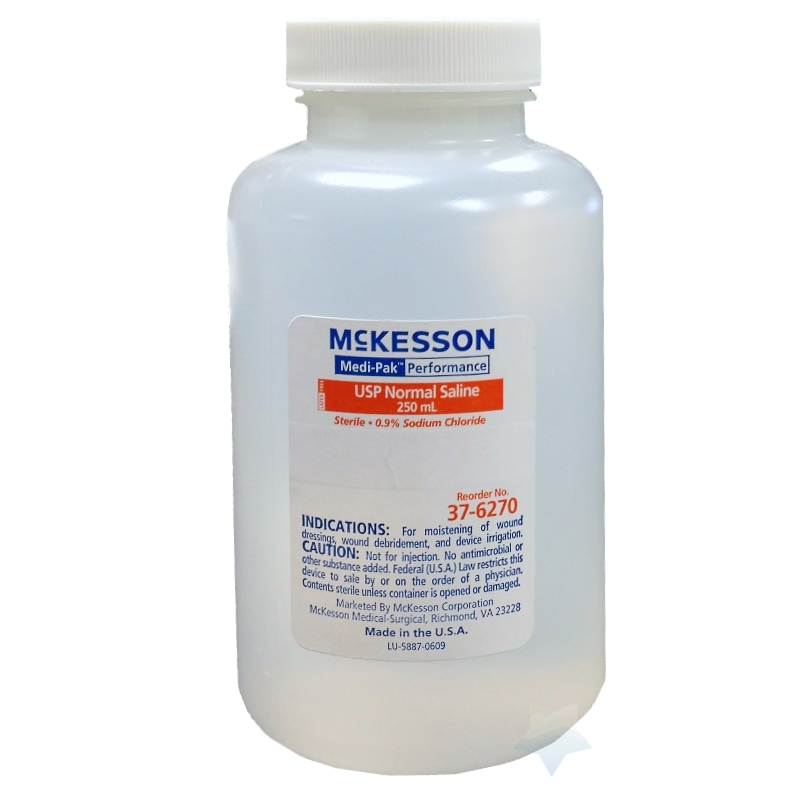Wounds need proper care to heal fast. They must be kept scrupulously clean, which is one of the most important steps in healing process. Any loose debris or bacteria can lead to infection and prevent healing. Unless your doctor tells you otherwise, cleanse the wound every time you change a bandage or dressing. Saline solution for wounds is one of the best answers for keeping the wounds as clean as possible.

How Does Saline Solution Work for Wounds?
Saline solution is great at cleaning wounds, which is why it is often used in hospitals and outpatient care centers. Saline solution washes debris away from the wounds, dissolves dried blood, and gets rid of irritants and bacteria. Besides, it also moisturizes wounds, which is why it’s safe to put it on a piece of gauze directly over the wound. Saline solution does not burn or irritate the wound, which makes it superior to soap, water and other cleaning products. It will not damage the tissues or take fluids from the wound bed.
Saline solution is sold over the counter at pharmacies and can be made at home as well. It’s easy to find and surprisingly cheap. There are generally no issues of having an allergic reaction. It doesn’t stop the good bacteria from doing its work of repairing the skin.
However, it is important to remember that even though saline is a great way to clean wounds, it won’t actively disinfect the area. For this purpose, stronger solutions like hydrogen peroxide are required. It won’t also remove oily substances from the wound like soap.
How to Use Saline Solution to Clean Wounds
Saline solution for wounds is simply labeled as 'normal saline'. Once the container is opened, bacteria might start to collect in 24 hours; therefore, smaller bottles that will be quickly used up are best.
When you first uncover the wound, it might appear to have a waxy, yellow film on top. This might seem startling, but it’s actually a very good sign: this means the wound has begun the healing process. Here’s how to go about cleaning the wound with saline:
- Wear a clean pair of gloves and place a towel under the wounded area.
- Wet a gauze pad with saline and start at the center of the wound, cleaning outward in gentle strokes. Always clean toward the outside, rather than the inside, as this might drag germs into the wound.
- Clean away any liquid drainage from the wound.
- Use a new gauze pad when the first one becomes dirty. Be generous with the pads and saline.
- Go through the process a second time.
- Dry the skin by patting it gently with a soft, clean towel.
- Make note of any problems with the wound, such as odor, redness or swelling, before applying a new dressing. Significant problems should be brought to the attention of the doctor.
How to Make Saline Solution at Home
You can make a saline solution for wounds at home. Here’s how:
Ingredients
- One cup of water
- ½ tsp of plain, non-iodized salt
Directions
- Pour one cup of water and ½ tsp of salt into a very clean pan.
- Put a lid on the pan and boil for 15 minutes. The lid will keep the water from evaporating.
- Let the solution cool down.
- Pour the solution into a sterile vessel. To ensure it is sterile, you can boil it before use.
More Tips for Wound Care at Home
When caring for the wound at home, follow these tips:
- Keep the wound very clean and wrapped at all times to prevent bacteria from getting into it. If it is an open wound, infected or blistered, use an antibiotic ointment before applying the gauze. Closed skin wounds can be softened with petroleum jelly. Always use a sterile bandage or covering.
- Eat more protein while you are healing. Skin is made up of proteins, so the more you put into your body after an injury, the better it is. Your body also uses proteins to create antibodies, boost your immune system, reduce inflammation and help the wound site heal. A lack of protein at this stage will delay the recovery and might actually increase the risk of serious infection.
- Turn to vitamins and minerals to help. Though a saline solution for wounds is great, nothing will replace the healing powers of the proper diet. You will want to use B5 to accelerate the healing, B1 to help build collagen and vitamin A to form scar tissue. Vitamin E helps heal the skin, vitamin C helps the skin stay more elastic, and zinc can stimulate your body to heal the wound faster. Take these vitamins and minerals from diet or from supplements approved by your doctor.
- If you have diabetes, monitor your blood sugars very carefully. High blood sugars can make it much more difficult for a wound to heal, and also make it much more likely for a wound to become infected. Your blood sugars might also go up or down depending upon how your body responds to the wound. Always be ready to speak to your doctor or dietitian if you are suffering from high blood sugar levels.